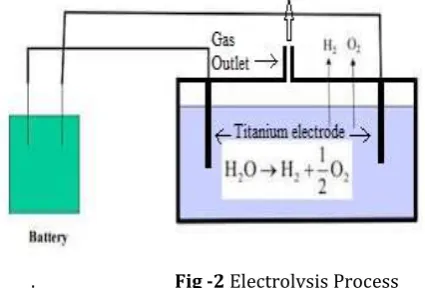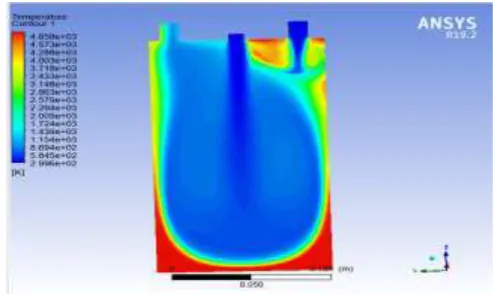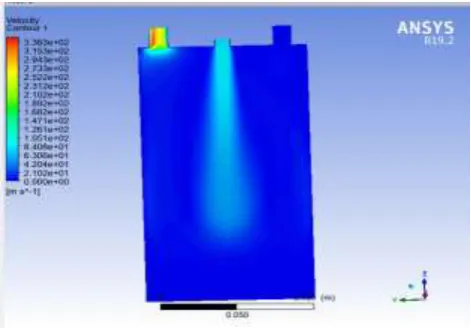© 2019, IRJET | Impact Factor value: 7.211 | ISO 9001:2008 Certified Journal
| Page 2362
DESIGN AND DEVELOPMENT OF OXY-HYDROGEN ENGINE
S. Mohanavellan
1, R. Dhanasekar
2, V. Gokulraj
3, K. Hariraj
4, S. Jagdeshwaran
51
Assistant professor, Dept.of Mechanical Engineering, KSR Institution for Engineering and Technology,
Tamilnadu, India
2
Student, Dept.of Mechanical Engineering, KSR Institution for Engineering and Technology, Tamilnadu, India
---***---Abstract -Electrolysis utilization is the process in which the separation of water molecules undergoes into oxygen and hydrogen gas, it is the basic step in this project. The electrochemical process for the separation of water molecules is carried out by the supply of electrical voltage to the electrolyte solution, which is the combination of the catalyst-potassium oxide and distilled water. The electric current is applied to the electrolysis process through the titanium electrode, both electrolyte and electrode are execute the high performance for the continuous formation of oxygen and hydrogen gas to the oxy-hydrogen generator. The produced oxy-hydrogen gas is used as the fuel for the internal combustion engine. Water is one of the by-products of the combustion process which also decreases the temperature of the combustion chamber. Finally the performance of oxy-hydrogen fuel used engine is tested and compare with the performance of engine with petrol as a fuel.
Key Words: electrochemical process, electrode, catalyst, HHO gas, spark ignition engine.
1. INTRODUCTION
The fossil fuels are the more advantagable source for the energy formation. The research on regarding the usage of fossil fuels are become increases now a days, there is more increasing in the population from last few years which also tends to the growth in automobiles for the transport purpose, by which the usage of petrol and diesel became more higher. Large number of automobiles usage produce more effective gases to the environment which causes increases in the global warming, pollutant air which is the major problem creating case to the environment living beings. To overcome this all problems the alternate fuel search is undergone.
The fossil fuels are non-renewable resource such as coal, oil and natural gas. By using the fossil fuel the formation of electricity, fuel of the automobiles is become cheapest. If the fossil fuels are used are for energy resource the emission level became reduces, while also using the fossil fuels it produce harmful gases such as carbon dioxide, carbon monoxide and sulphur compounds, etc. the tyre one company as starts the project researches on producing alternate fossil fuel use automobiles. In those researches the hydrogen fuel is taken as the major predicted fuel in the upcoming future, another reason to change to hydrogen fuel for
transportation is that our reliance on fossil fuels in becoming a problem.
Hydrogen is the less pollutant gas which is widely obtained from the water the electrolysis process is used to the formation of oxy-hydrogen gas from the water. By applying the power source on the water with the help of titanium electrode the water molecules can be splitted into two particles hydrogen and oxygen. For the continuous formation of hydrogen the titanium electrode is used which is more reactive to the electric power and distilled water. Hence the producing hydrogen is enough to run the two stroke engine continuously without any troubles.By the oxy-hydrogen used engine, the various type of analysis is to be taken and compare the performance level of the two stroke engine with taking petrol as the fuel. According to the oxy-hydrogen as a fuel the performance is more efficient, the mileage of the engine will increase, the load capacity tends to higher gradually the emissions level is reduced, the exhaust gases such as CO2, CO, HC, NO2, etc are reduced in amount
which doesn’t effect the environment that much as compared to the petrol as the fuel and the consumption of the oxy-hydrogen is also less where the petrol is high.
1.1 Literature Survey
© 2019, IRJET | Impact Factor value: 7.211 | ISO 9001:2008 Certified Journal
| Page 2363
1.2 EXPERIMENTAL SETUP
[image:2.595.96.253.130.281.2]Engine
Fig -1 Engine
Here in this experiment the TVS 50 engine is used for the test, while in this engine no modification is required. The produced oxy-hydrogen fuel is introduced in the engine as a fuel. It is a two stroke internal combustion engine which completes a power cycle with two strokes (up and down movements) of the piston during only one crankshaft revolution. In two stroke engine, the end of the combustion stroke and the beginning of the compression stroke happen simultaneously, with the intake and exhaust function occurring at the seam time.
[image:2.595.47.264.520.725.2]Two stroke engines often have a high power-to-weight ratio, power being available in a narrow range of rotational speeds called the “power band”. Compared to four-stroke engines, two-stroke engine have a greatly reduced number of moving parts, and so can be more compact and significantly lighter, the specification of TVS50 engine are in the below table,
Table -1 Engine specification
Oxy-Hydrogen Generator
The oxy-hydrogen generator is a device that is designed to produce hydrogen and oxygen gas from water by the electrolysis process. The generator setup is of closed container containing electrodes of Titanium which formulates the continuous formation of Oxy-hydrogen gas and being the electrodes are connected to two terminals of the power source, here the electrolyte used is potassium hydroxide which is more reactive with the electric charges, the generator housing is made from low density plastic, with a cover made from the plastic material. The exit valve for the gas is situated at the middle of the cover connected to hose and it to the oxy-hydrogen storage tank and then to the engine with a constant and controlled condition.
The Electric current is passed through the titanium electrodes to the water to break down the water molecules to produce hydrogen and oxygen gases. If there is partition in the generator chamber, the pure hydrogen and oxygen gases can be collected separately but in this case, they are collected together as a mixture of hydrogen and oxygen gases called oxy-hydrogen gas, the oxy-hydrogen material details are on the below table;
Table -2 Materials of HHO generator
S.NO PARTS MATERIAL
1 Cover Thermosetting plastic
2 Anode Titanium
3 Cathode Titanium
4 Housing Conventional plastic
5 Vent PVC
Electrolysis Process
Electrolysis is the chemical process of using an electrical current to stimulate non-spontaneous reactions. A non –spontaneous reaction is one that needs energy to work while it proceeds. In other words, the process would not happen on its own, as it goes in an unfavorable, or a reversed, direction. Important uses include its role in separation metals from a natural source, such titanium ore. Other useful benefits for electrolysis include the purification of metals and decomposition of compounds like water.
The site where electrolysis occurs is in an electrolytic cell, which is a type of electrochemical cell that drives an electrical current using a non-spontaneous reaction. So, not like a cell in your body, but a container. Thus, these cells must have an energy source to drive the reaction in the reverse or opposite direction, like a battery.
This process will require an anode, a positively charged electrode, and a cathode negatively charged
No. of stroke 2
Max torque 5 Nm @ 3750 rpm
Max power 3.5bhp @ 5000rpm
Cubic capacity 50cc
Bore 46mm
Stroke 42mm
Mileage 66kmpl
Speed 50kmph
© 2019, IRJET | Impact Factor value: 7.211 | ISO 9001:2008 Certified Journal
| Page 2364
electrode. In this case, an titanium metal is the electrode. The electrodes are placed inside the container with the presence of electrolyte and electric current. The goal is to use electrolysis for the purpose of producing oxy hydrogen gas from the water. An electrolyte is a substance, frequently an ion conducting polymer that contains free ions, which carry electric current in the electrolyte. The potassium oxide is used as the electrolyte
Which is more efficient for the production of oxy hydrogen gas with the presence of electric current? The amount of electric current must be added equal the change in Gibbs free energy of the reaction plus the losses in the system. The losses can be arbitrarily close to zero, so the maximum thermodynamic efficiency equals the enthalpy change divided by the free energy change of the reaction. The electric input is larger than the enthalpy of the reaction, so sum energy is released in the form of heat. In some cases for instant, the electrolysis of water in to hydrogen and oxygen at high temperature and the heat energy is observed. This heat absorbed from the surrounding, and the heating value of the produced hydrogen is higher that the electric input.
. Fig -2 Electrolysis Process Electrolysis of acidified water
The energy efficiency of water electrolysis varies widely. The efficiency of an electrolyses is a measure of the enthalpy contained in the hydrogen (to undergo combustion with oxygen, or some other later reaction), compared with the input electrical energy. Heat/enthalpy values for hydrogen are well published in science and engineering texts, as 144MJ/Kg. Note that fuel cells(not electrolyses ), cannot use this full amount of heat/enthalpy, which has led to some confusion when calculating efficiency values for both types of technology. In the reaction, some energy is lost as the heat. Some reports quote efficiencies between 50% and 70% for alkaline electrolyses, however, much higher practical efficiencies are available with the use of PEM (Polymer electrolyte Membrane electrolysis) and catalytic technology such as 95% efficiency.
NREL estimated that 1 kg of hydrogen (roughly equivalent to 3 kg, or 4 l, of petroleum in energy terms)
could be produced by wind powered electrolysis for between $5.55 in the neat term and $2.27 in the long term.
About 4% of hydrogen gas produced worldwide is generated by electrolysis, and normally used onsite. Hydrogen is used for the creation of ammonia for fertilizer via the Haber process, and converting heavy petroleum sources to lighter fractions via hydro cracking.
The electrolysis of water produces hydrogen
2 H2O (l) 2 H2(g) + O2(g)
Electrodes of the process
An electrode in an electrochemical cell is referred as either an anode or a cathode. The anode is now defined as the electrode at which electrons leave the cell and oxidation occurs, and the cathode as the electrode at which electrons enter the cell and reduction occurs. Each electrode may become either the anode or the cathode depending on the direction of current through the cell. A bipolar electrode is an electrode that functions as the anode of one cell and the cathode of another cell. The anode and cathode both are of titanium material which is more reactant with the electric current and the electrolyte is potassium oxide, the titanium used for the continuous formation of oxy-hydrogen gas, the other electrodes like copper, stainless steel, iron,etc are not more effective to the continuous formation of gas .
The anode undergoes the oxidation process and the cathode undergoes reduction process, the chemical reactions of the electrode are:
Cathode (reduction): 2 H2O (l) + 2e- H2 (g) + 2 OH
-(aq)
Anode (oxidation): 4OH- (aq) O2 (g) +2 H2O (l) + 4e-
Combining either half reaction pair yields the same overall decomposition of water into oxygen and hydrogen:
Overall reaction: 2 H2O (l) 2 H2(g) + O2(g)
Storage Tank
[image:3.595.47.260.375.519.2]© 2019, IRJET | Impact Factor value: 7.211 | ISO 9001:2008 Certified Journal
| Page 2365
[image:4.595.319.566.171.318.2]within. Here the pressure gauge is used to monitor the pressure under the tank and two valves are used one for gas inlet, which is of non return valve and other one is normal flow control valve, which supply the gas for the engine. The gas from the electrolysis process container is directly store into the storage tank which will store the sufficient gas for the particular travel and allow the gas to the engine with the constant flow as per the requirement occurs.
Fig -3 Storage Tank
2. DESIGN
Fig -4 Experimental Design
2.1 ANALYSIS
Storage Tank Analysis
The storage tank analyse for the pressure as assuming the inlet pressure at 5bar and outlet pressure at 3bar, the gas enters at velocity of 0.5m/s into the tank.
Fig -5 Storage Tank Analysis
Temperature Analysis
[image:4.595.36.298.335.510.2]The figure 6 shows the temperature variation inside the combustion chamber when oxy-hydrogen is introduced as the fuel, .the temperature is high at the bottom corner of the chamber.
Fig -6 Temperature Analysis
Mass Fraction Analysis
[image:4.595.327.552.418.582.2]The figure 7 shows the hydrogen mass fraction present in the combustion chamber while the combustion takes place,it is concentrated at the center of the chamber.
Fig -7 Mass Fraction Analysis
Pressure Analysis
© 2019, IRJET | Impact Factor value: 7.211 | ISO 9001:2008 Certified Journal
| Page 2366
Fig -8 Pressure Analysis
Velocity Analysis
[image:5.595.37.273.348.512.2]The figure 9 shows the velocity of the oxy-hydrogen gas while in the beginning of the compression process so, it is higher at the inlet valve.
Fig -9 Velocity Analysis
3. CONCLUSION
By using the oxy-hydrogen gas as fuel for the two stroke bike engine, the various improvements as been analyzed from the engine performance and exhaust gas. the exhaust consist of water vapor which helps to reduced the temperature of the engine. The mileage of the engine will able to increase, increase in horsepower, also reduce the emissions levels and the engine life became longer. By using Titanium as the electrodes for the electrolysis process the continuous formation of Oxy-hydrogen is obtained which tents to continuous running of the engine.
REFERENCES
[1] M.M. Noor, M.M. Rahman, M.R.M. Rejab, M.S.M. Sani K. Kadirgama, Study of air fuel ratio on engine performance of direct injection hydrogen fueled engine. 2008.
[2] S.e.A. Musmar, A.A. Al-Rousan, Effect of HHO gas on combustion emissions in gasoline engines, Fuel 90 (10) (2011)3066–3070.
[3] Musmar SA, Al-Rousan AA. (2011). Effect of HHO gas on combustion emissions in gasoline engines. Journal of Fuel 90(10): 3066-3070. https://doi.org/ 10.1016 /j. fuel. 2011.05.013.
[4] Peavey MA. 2003, ―Fuel from Water: Energy Independence with Hydrogen‖, (Merit Products)
11th Edition p. 135-137.
BIOGRAPHIES
S JAGDESHWARAN



